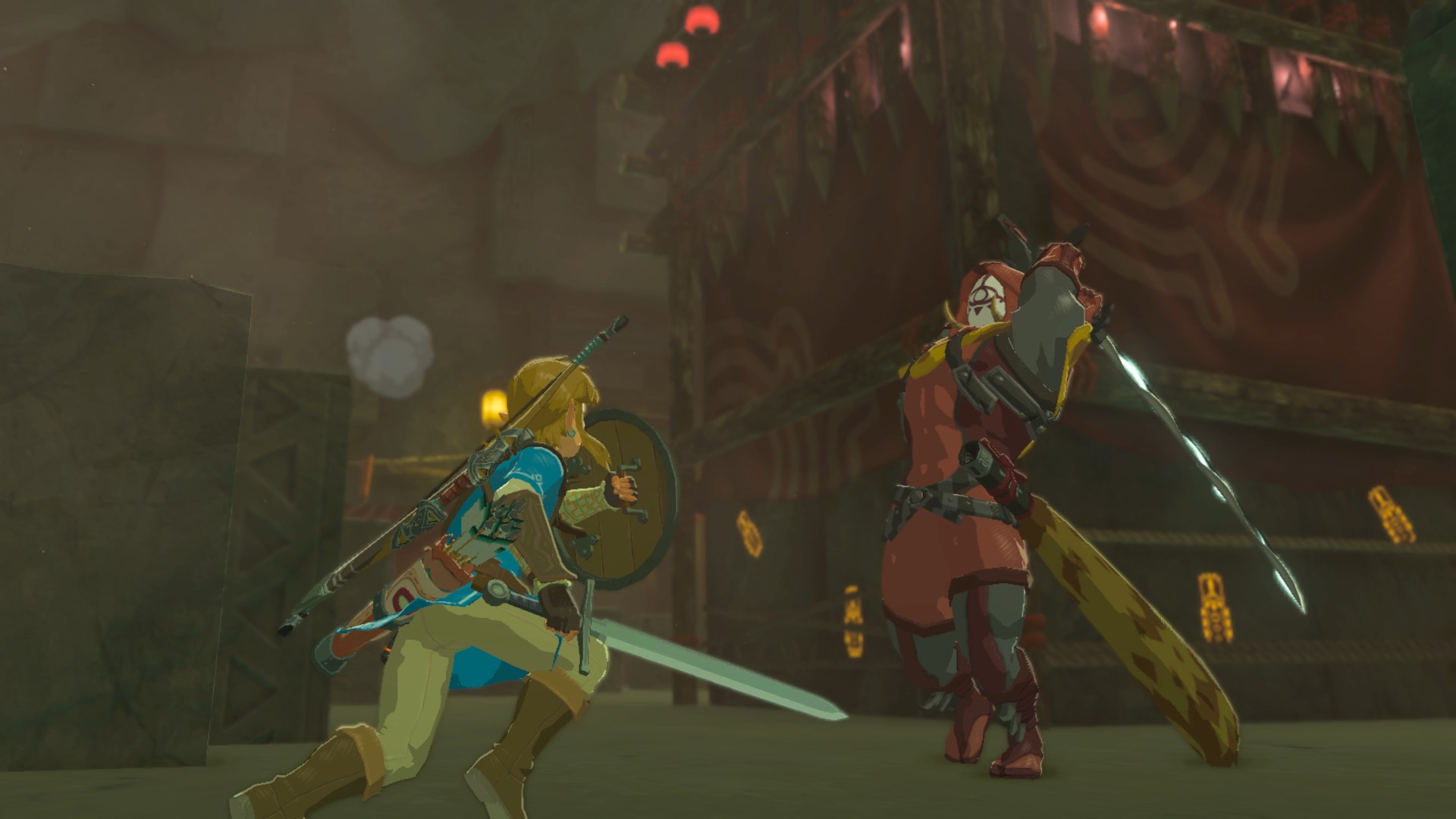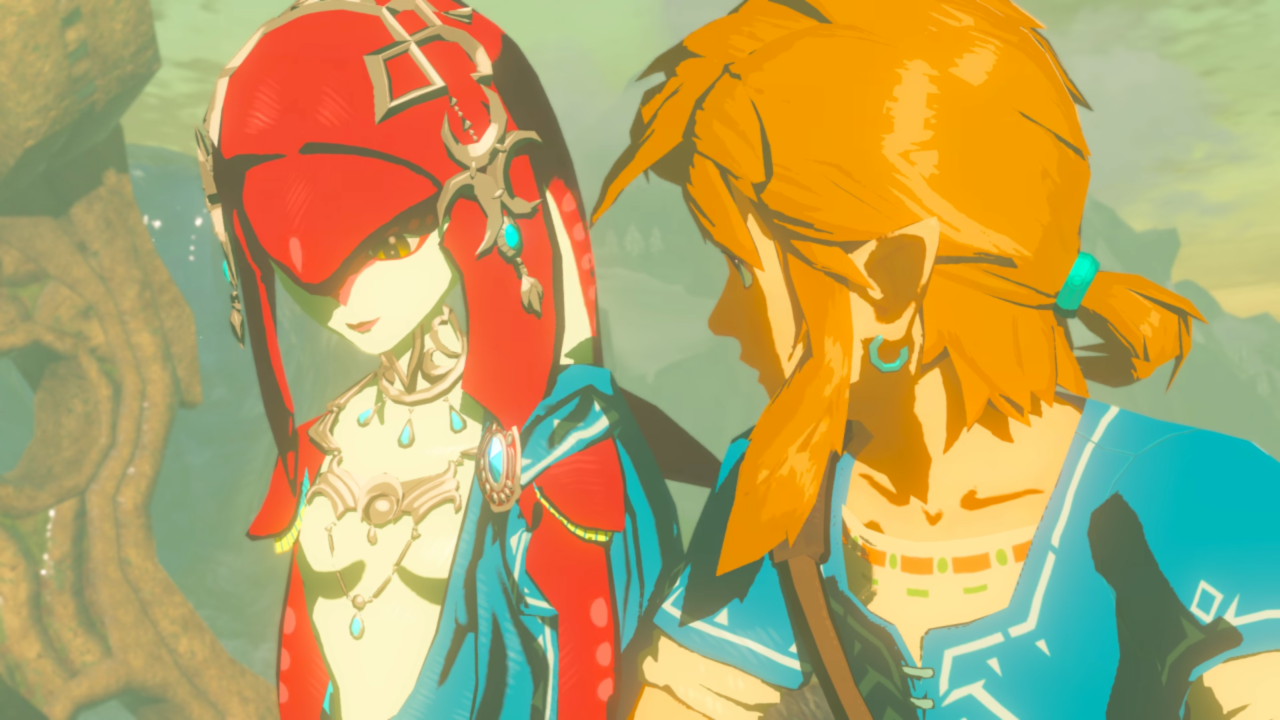I had to reach the first dungeon before The Legend of Zelda: Breath of the Wild finally clicked with me.
I’d been running around aimlessly, exploring the gorgeous, painterly kingdom of Hyrule for a few hours, but I couldn’t quite grasp what the game wanted me to do. Directionless, I stumbled upon a Zora (the blue-skinned humanoids of the Zelda universe) at the top of one of the games many Sheikah Towers.
The Zora told me he’d been trying to get the attention of another Zora on the bridge below him for hours, but he was just out of reach. So I floated down on my paraglider and was surprised to find the prince of Zora’s Domain waiting below. He immediately recognized that I was a Hylian and recruited me to help him save his homeland from some existential threat involving rain. I happily obliged, and from that moment on, everything suddenly seemed to fall into place. I’d finally found two puzzle pieces that fit together.
Breath of the Wild is more like the original Legend of Zelda on the Nintendo Entertainment System than any other game in the series. Following a brief series of tutorial missions, Link is set loose on the largest world that Nintendo has ever constructed and one of the most open virtual worlds in video game history.

What do I mean by open? I mean you can actually go anywhere. Though limited by a stamina bar, Link has the ability to climb virtually any surface in the game, save for a few that would make certain puzzles trivial. If you want to climb a mountain, you don’t have to find a path — just latch on to the face of the nearest cliff and start climbing. It’s not always the most efficient way to traverse Hyrule, but it’s definitely the most entertaining.
But before you can start clambering your way over mountains, you have to slog through a protracted (but necessary) tutorial that lets you know you aren’t playing yet another 3D Zelda game. Link walks out of an odd crypt of sorts with nothing but the clothes on his back and a Sheikah Slate on his hip (a device which doubles as a map, a key and a camera, among other things). No Master Sword, no shield, no bow.
For Link to survive in this world, he has to become a scavenger. Everything is collectable, from the apples on the tree to the swords and spears wielded by patrolling enemies. When you first walk out into the world, you’ll see a tree branch lying in the grass. Naturally, you pick it up, only to learn that this little stick will be your first ever weapon. It doesn’t do much damage, but until you find something more appropriate, it’s all you’ve got. Or until it breaks, which every weapon, shield and bow eventually does.

Upgrading Link’s arsenal quickly shot to the top of my list of things to accomplish, but with a limited inventory and breakable equipment, it became a strategic challenge of sorts to decide which weapons I wanted to bring with me and which I would leave behind. Then when I did run into a group of powerful baddies or a miniboss with a long health bar, I had to decide which weapons I was willing to expend.
Grappling with these decisions was simultaneously stressful and thrilling. There were times when I would approach an encounter with enough firepower to make Rambo jealous, yet I’d still end up dead. Other times, I had hardly an arrow to my name, but still managed to sneak my way through an encampment, taking out one foe at a time until nothing was left but the entrails of my enemies.
And then there were a whole bunch of times when I just hightailed it out of there.
Thankfully, as I scurried away from one thing, I was always scurrying toward another. All of the best Zelda games have put discovery above all else. From the original NES game to Link’s Awakening on the Game Boy to Wind Waker on the GameCube, players have spent hours walking, bombing and sailing their way from one corner of the map to the other in search of secrets. Breath of the Wild puts them all to shame.

“Around every corner” is a hackneyed, vapid phrase, but it’s the only way to describe the amount of content in the latest Zelda. There are new shrines, interesting NPCs, hidden treasures, environmental challenges and picturesque vistas around every. single. corner. I spent at least 30 hours completing quests, conquering dungeons and beating bosses, but there is still an entire game’s worth of content I haven’t discovered.
It’s the little things that elevate Breath of the Wild. During his quest, Link will occasionally run into a pack of wild horses grazing in a field. Not only can he sneak up on one and jump on its back, attempting to calm it before it bucks him off; he can register it at one of the many stables and give it a name. As vast as the world is, running from one location to the next can become grueling, even with the fast travel system. It took me a while to warm up to the idea of riding around on a horse, but by the end of the game, I was going out of my way to find new horses to tame and register to add to my collection.
As huge and compelling as the world of Breath of the Wild is, it comes at a cost. Gone are the winding, multi-story dungeons of Zelda past. I won’t spoil how the developers have replaced them, but, once again, if you’re expecting an experience along the lines of Ocarina of Time or Link to the Past, you’re going to be taken aback. (I almost typed “disappointed,” but I have a feeling you’re not going to be disappointed.)

Some of the innovations in Breath of the Wild fell flat for me. Although the cooking mechanic — which allows Link to use the countless ingredients he collects around the world to cook up meals or concoct elixirs — fits thematically and is surprisingly fleshed-out, it becomes a chore to sort through all of the materials Link collects while slaying enemies and running around the disparate environs of the world. And while you’re welcome to ignore cooking altogether, you’re going to need healing items in some of the more difficult fights.
Speaking of difficult, this is a tough game. There’s a reason I keep bringing up the NES game — not only was it open-ended, it was far more challenging than what you expect from Nintendo nowadays. Breath of the Wild hearkens back to a bygone era, where death was both an inevitability and a learning tool. This new Zelda will kill you — repeatedly! — but it’s up to you to conquer it. Nintendo is done holding your hand.
The highest praise I can offer this game is that I desperately want to continue writing about it. I want to tell everything what I found when I flew to that island in the corner of the map. I want to talk about how I beat that one boss I had no business beating. But I also want to hear how everyone else conquered Hyrule their way, without an instruction manual to guide them or an arrow constantly pointing them in the right direction.
Whether or not The Legend of Zelda: Breath of the Wild is the start of a new era for Nintendo or simply an anomalous blip on the radar, it’s one of the best games in the history of one of the most storied video game franchises of all time. In one fell swoop, Nintendo has redefined Zelda as a series and open world gaming as a whole. Now, if you don’t mind, I’m going back to Hyrule.
Nintendo provided BGR with a copy of The Legend of Zelda: Breath of the Wild on Switch for the purposes of this review.








